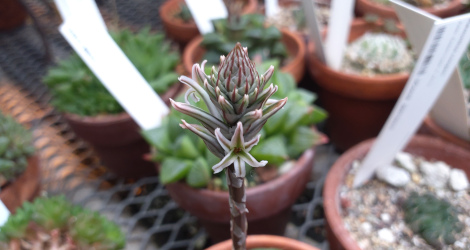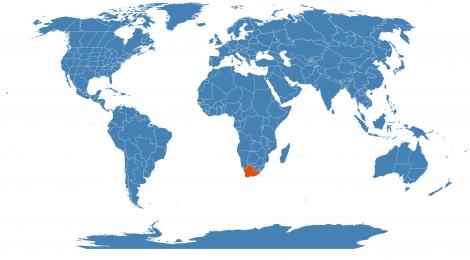Accession Data:
Haworthia retusa (L.) Duval
subg. Haworthia sect. Retusae subsect. Retusae
- Common Name:
- Family: Asphodelaceae
- Culture: Does best in partial sun with relatively generous watering.
Accession Data:
- Accession # 200900031
- Source: J. Lamacchia
- Provenance: EA1208, Pienaarsrivier, Western Cape, South Africa
- Accession Date: 03-24-2009
- Bench: 2205 - XER:Namib / Karoo B
- Currently: active - healthy
- Qty: 2 confirmed on 03-24-2025
Classification:
- Division: Magnoliophyta
- Class: Liliopsida
- SubClass: monocots
- Order: Asparagales
- SubOrder:
- Family: Asphodelaceae
- SubFamily: Asphodeloideae
- Tribe:
- SubTribe:
Flowering Data:
This accession has been observed in bloom on:| Year | Jan | Feb | Mar | Apr | May | Jun | Jul | Aug | Sep | Oct | Nov | Dec | ||||||||||||||||||||||||||||||||||||||||
|---|---|---|---|---|---|---|---|---|---|---|---|---|---|---|---|---|---|---|---|---|---|---|---|---|---|---|---|---|---|---|---|---|---|---|---|---|---|---|---|---|---|---|---|---|---|---|---|---|---|---|---|---|
| 2025 | ||||||||||||||||||||||||||||||||||||||||||||||||||||
| 2024 | ||||||||||||||||||||||||||||||||||||||||||||||||||||
| 2023 | ||||||||||||||||||||||||||||||||||||||||||||||||||||
| 2022 | ||||||||||||||||||||||||||||||||||||||||||||||||||||
| 2021 | ||||||||||||||||||||||||||||||||||||||||||||||||||||
| 2020 | ||||||||||||||||||||||||||||||||||||||||||||||||||||
| 2019 | ||||||||||||||||||||||||||||||||||||||||||||||||||||
| 2018 | ||||||||||||||||||||||||||||||||||||||||||||||||||||
| 2017 | ||||||||||||||||||||||||||||||||||||||||||||||||||||
| 2016 | ||||||||||||||||||||||||||||||||||||||||||||||||||||
| 2015 | ||||||||||||||||||||||||||||||||||||||||||||||||||||
| 2014 | ||||||||||||||||||||||||||||||||||||||||||||||||||||
| 2013 | ||||||||||||||||||||||||||||||||||||||||||||||||||||
| 2012 | ||||||||||||||||||||||||||||||||||||||||||||||||||||
| 2011 | ||||||||||||||||||||||||||||||||||||||||||||||||||||
References (internal):
- EEB Greenhouse Holdings native to: Cape Provinces
References (external):
- The Plant List (2013). Version 1.1. Accessed 31 March 2105.
- WCSP (2015). World Checklist of Selected Plant Families. Facilitated by the Royal Botanic Gardens, Kew. Accessed 31 March 2015.
- Angiosperm Phylogeny Website at MoBot. Last accessed on Tuesday, 03 December, 2019.
data regenerated on Tue, 06 May 2025 11:06:42 -0400 [bcm v4.0]
Images:

Additional images for this accession:
Click on thumbnails to enlargeCurrent Accessions in the Asphodelaceae
Subfamily Asphodeloideae
- Aloe albiflora

- Aloe alooides

- Aloe arborescens

- Aloe bakeri

- Aloe berevoana W/C

- Aloe branddraaiensis W/C

- Aloe burgersfortensis

- Aloe cooperi W/C

- Aloe cremnophila

- Aloe descoingsii

- Aloe dorotheae

- Aloe ferox

- Aloe globuligemma W/C

- Aloe jucunda

- Aloe juvenna

- Aloe krapohliana

- Aloe longistyla


- Aloe maculata

- Aloe marlothii W/C

- Aloe melanacantha

- Aloe nobilis
- Aloe parvula


- Aloe polyphylla

- Aloe rauhii

- Aloe rivierei

- Aloe spicata

- Aloe thraskii

- Aloe vera


- Aloe vogtsii

- Aloiampelos ciliaris

- Aristaloe aristata

- Asphodeline liburnica

- Astroloba congesta

- Bulbine frutescens

- Bulbine margarethae W/C

- x Gasterhaworthia Royal Highness
- Gasteria batesiana


- Gasteria brachyphylla W/C

- Gasteria brachyphylla var. bayeri

- Gasteria disticha W/C

- Gasteria ellaphieae

- Gasteria glauca W/C

- Gasteria glomerata


- Gasteria nitida var. armstrongii

- Gasteria obliqua


- Gonialoe variegata

- Haworthia attenuata var. radula


- Haworthia blackburniae


- Haworthia cf. aristata W/C

- Haworthia cooperi W/C

- Haworthia cooperi var. dielsiana

- Haworthia cooperi var. truncata W/C

- Haworthia cymbiformis


- Haworthia cymbiformis


- Haworthia gracilis var. tenera

- Haworthia pygmaea var. acuminata W/C

- Haworthia magnifica var. splendens W/C


- Haworthia marumiana var. batesiana

- Haworthia mirabilis W/C

- Haworthia mirabilis var. paradoxa

- Haworthia mirabilis var. triebneriana

- Haworthia retusa W/C


- Haworthia retusa


- Haworthia truncata W/C


- Haworthia truncata


- Haworthia turgida

- Haworthia venosa subsp. tessellata
- Haworthiopsis glauca

- Haworthiopsis limifolia W/C

- Haworthiopsis limifolia W/C

- Haworthiopsis limifolia W/C

- Haworthiopsis longiana

- Haworthiopsis reinwardtii

- Haworthiopsis viscosa W/C


- Kumara plicatilis


Subfamily Hemerocallidoideae
Subfamily Xanthorrhoeoideae
W/C = Wild Collected = indicates flowering in past 14 days
= indicates flowering in past 14 days
 = images available for this accession
= images available for this accession
 = map available for this accession
= map available for this accession
 = accession added within past 90 days
= accession added within past 90 days






